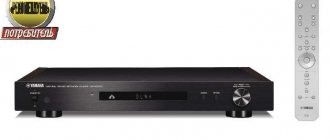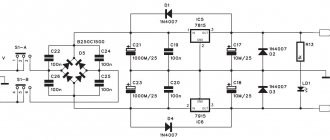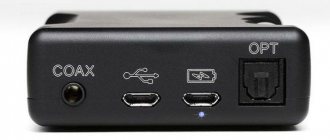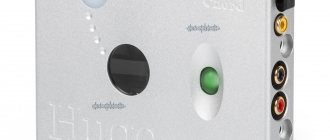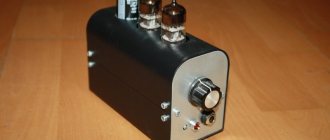Statistics show that 68% of our compatriots who have reached the age of 18 use the Internet daily, and the number of teenagers aged 12-17 who go online daily is 89%. It has been established that the majority of Internet users are busy searching and listening to music. However, the quality of the sound received from a modern gadget (phone, tablet, player or laptop) leaves much to be desired, since despite the huge number of headphone models that exist today, not all of them, when paired with a signal source, are capable of producing excellent sound. Each model needs an individual device that could help it reveal all its technical capabilities and convey the sound exactly as intended by the developers. This was the main reason for the creation of various designs of headphone amplifiers, which turned out to be very, very popular.
Do you need headphone amplifiers?
There is a fairly persistent misconception that headphone amplifiers are only needed to increase the volume of the received audio signal. But in fact, amplifiers serve to perform two tasks simultaneously: to amplify the sound signal received from the audio system and transmit this signal without the slightest distortion . It is the second task that is the main one for headphone amplifiers, since at normal volume in modern models of phones and tablets the quality of the sound signal is still not up to par.
Usually, to convince the next potential buyer of a headphone amplifier, sellers give the following example from our life: two cars are driving at the same speed of 100 km/h. But one car drives confidently, while the other skids due to engine imbalance and poor suspension. Likewise, an amplifier, while coping with an increase in sound power, must also be able to convey sound quality. For example, the linear output from an audio system with a low-impedance load creates quite strong distortions, literally distorting the sound, and only an amplifier can correct the situation and give the user true pleasure from listening to a particular melody. Modern amplifier models confidently control the operation of headphones, creating the highest sound quality.
Audio quality factor (i.e. signal path)
Most commonly referred to in professional audio circles, the signal path—or signal chain—refers to each and every component that comes into contact with your audio signal. In our case, this probably includes a digital source, a DAC, an amplifier, a pair of headphones, and finally your ears. The higher the quality of the signal path, the higher the sound quality will be. While you can't replace the last stop on the list (yet), everything else is already in play.
When paired with good headphones, quality amplification can do some pretty cool things.
You may have come here to learn about headphone amplification, but we'd be remiss if we didn't point out that a DAC is an extremely important stop for a good audiophile train. A DAC is an important portal between you and your audio because it converts audio data from digital information—a simple code of ones and zeros—into electrical current. The better the transfer point, the better the sound.
Quality amplification can also improve the sound quality of almost any pair of headphones starting at around $100; basically, any model built on high-quality sound, and not on colors and cute design. When paired with a good pair of headphones (and a good DAC), quality amplification can do some pretty cool things. He can give the sound more or less color as desired. It can make the sound clearer and more balanced, or, on the other hand, warmer, richer and smoother. A good headphone amplifier can also affect the sound in other ways, including isolating the current flowing inside the device to limit crosstalk (interference between stereo channels) that can ruin the final product.
The best amplifiers and DACs produce cleaner, clearer, and less distorted signals. The better the signal that reaches your headphones, the better your sound will be.
Features of different types of headphone amplifiers
Tube amplifiers for the most part help create a warm and comfortable sound. They are most often used when working with high-impedance headphones. The operation of these amplifiers in the dark is especially attractive, when the lamps give a special charm to the surrounding environment with their glow. The lamps can be located both inside the amplifier housing and outside. In the latter case, it should be borne in mind that with amplifiers of this type, the lamps heat up to a significant temperature.
Transistor amplifiers are capable of reproducing sound very clearly and accurately, without creating any “flavor” coloring. This type of amplifier also works great with low impedance headphones. Their sizes are smaller than lamp ones, and they require much less electricity to operate.
Hybrid amplifiers have both tubes and transistors in their design, and therefore have the advantages of both types of amplifiers. Most often, hybrid amplifiers are used for low-impedance headphones. The lamp gives the sound softness, and the transistor provides sufficient power for high-quality work.
Op-amp (op-amp) amplifiers have high input impedance and low output impedance. At the output, they create a current of the order of 20-50 mA per channel. This amplifier does not change the received audio signal, so the music in the headphones sounds exactly as the original source transmits it, without distortion. Reducing the signal level is achieved using the volume control.
Stationary amplifiers only work when connected to the electrical network, which does not allow them to be used away from an outlet, that is, on the road. They are indispensable when working with a laptop or computer. Whereas portable amplifiers , powered by batteries or a rechargeable battery, can be used anytime, anywhere.
Stationary sound sources
For most of us, the stationary source of sound is a computer. It's good if with a discrete sound card. But listening to music at home can reach a new level if the source is a special player + DAC. In fact, there are several solutions:
- Stationary player with built-in high-quality DAC;
- Player and separate DAC;
- Computer and DAC.
By stationary player here I mean network players that can play music from flash drives, external HDDs, via Wi-Fi, from a phone (processing the signal independently), and CD\DVD players. The easiest way is to buy a high-quality external DAC and listen to music from your computer through it. All major manufacturers of audio equipment have in their arsenal such devices for every taste and budget.
If you follow the rather long and winding audiophile path, you will learn about “audiophile computers,” which are specially built to play music with a minimum of interference and distortion. And about rearranging electrical wiring for the sake of sound.


